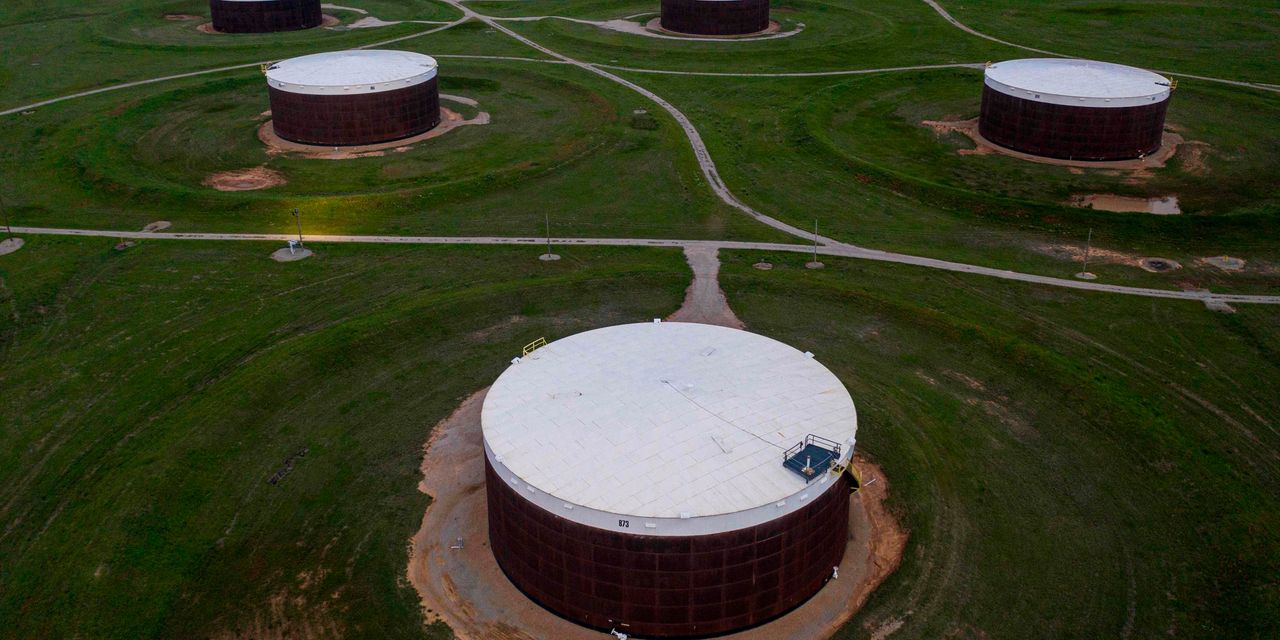Oil futures ticked higher early Wednesday, bouncing modestly after a rout in the previous session that took both the U.S. and global benchmarks back below $100 a barrel.
Price action
-
West Texas Intermediate crude for August delivery
CL.1,
+0.65% CLQ22,
+0.65%
rose 73 cents, or 0.8%, to $96.57 a barrel on the New York Mercantile Exchange. -
September Brent crude
BRN00,
+0.54% BRNU22,
+0.54% ,
the global benchmark, was up 64 cents, or 0.6%, at $100.13 a barrel on ICE Futures Europe. -
Back on Nymex, August gasoline
RBQ22,
-0.95%
fell 0.7% to $3.2408 a gallon, while August heating oil
HOQ22,
+2.15%
rose 1.8% to $3.7301 a gallon. -
August natural gas
NGQ22,
+3.86%
rose 3.7% to $6.394 per million British thermal units.
Market drivers
Fears of recession and the potential for renewed COVID restrictions in China were blamed for a rout that saw WTI slump nearly 8% and Brent down more than 7% with each seeing their lowest finish since April on Tuesday.
Analysts said the drop left crude oversold and due for a bounce.
“Brent is in oversold territory at the moment, and the fundamentals do not justify the scale of the selloff we have seen in recent weeks. The oil market is still tight, as reflected in the prompt Brent spread. The outlook is for this tightness to persist,” said Warren Patterson, head of commodities strategy at ING, in a note.
Meanwhile, the International Energy Agency on Wednesday said the worst oil-supply crisis in decades is showing tentative signs of easing as flagging economic growth weighs on demand for crude while sanctions on Russia’s oil industry are having less impact on production than expected.
The Paris-based agency cut its demand forecast for 2022 by 240,000 barrels a day to 99.2 million barrels a day in its monthly report. Demand in 2023 will also be 280,000 barrels a day less than earlier forecasts at 101.3 million barrels a day, the report said. The agency raised its supply forecast for the year by 300,000 barrels a day to 100.1 million barrels a day. The IEA raised its forecast for Russian crude output this year by 240,000 barrels a day to 10.6 million barrels a day.
However, IEA Executive Director Fatih Birol this week warned that the worst of the energy crisis may not be over and that Europe faces a “very, very difficult” winter as it deals with curtailed natural gas supplies from Russia.
U.S. supply data will also be in focus on Wednesday. The American Petroleum Institute reported late Tuesday that U.S. crude supplies rose by 4.8 million barrels for the week ended July 8, according to sources. The API data also reportedly showed weekly inventory increases of 2.9 million barrels for gasoline and 3.3 million barrels for distillates.
Oil stocks at the Cushing, Okla., delivery hub were up by 298,000 barrels last week, sources said.
Official inventory data from the Energy Information Administration will be released on Wednesday. On average, analysts polled by S&P Global Commodity Insights said the EIA is expected to show weekly crude inventories up by 1.4 million barrel, along with a supply decline of 200,000 barrels for gasoline and an increase of 900,000 barrels for distillates.
